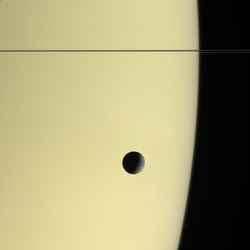
Tethys floating past the massive golden globe of Saturn. Image credit: NASA/JPL/SSI Click to enlarge
Tethys floats before the massive, golden-hued globe of Saturn in this natural color view. The thin, dark line of the rings curves around the horizon at top.
Visible on Tethys (1,071 kilometers, or 665 miles across) are the craters Odysseus (top) and Melanthius (bottom). The view looks toward the anti-Saturn side of Tethys.
Images taken using red, green and blue spectral filters were combined to create this color view. Tethys is apparently darker than Saturn at these wavelengths. The edge of the planet appears fuzzy, which may indicate that we are seeing haze layers that are separated from the main cloud deck.
The images were acquired by the Cassini spacecraft narrow-angle camera on Dec. 3, 2005, at a distance of approximately 2.5 million kilometers (1.6 million miles) from Saturn. The image scale is 15 kilometers (9 miles) per pixel on Saturn and 13 kilometers (8 miles) per pixel on Tethys.
The Cassini-Huygens mission is a cooperative project of NASA, the European Space Agency and the Italian Space Agency. The Jet Propulsion Laboratory, a division of the California Institute of Technology in Pasadena, manages the mission for NASA’s Science Mission Directorate, Washington, D.C. The Cassini orbiter and its two onboard cameras were designed, developed and assembled at JPL. The imaging operations center is based at the Space Science Institute in Boulder, Colo.
For more information about the Cassini-Huygens mission visit http://saturn.jpl.nasa.gov . The Cassini imaging team homepage is at http://ciclops.org .
Original Source: NASA/JPL/SSI News Release.
